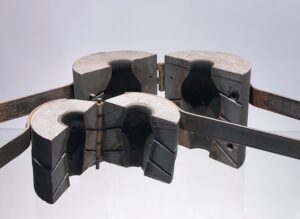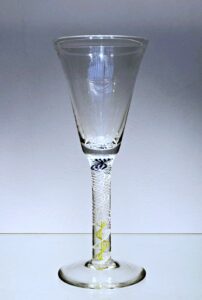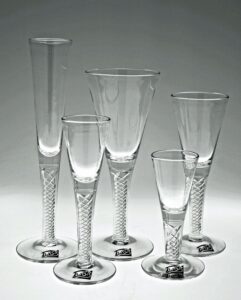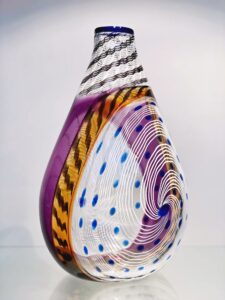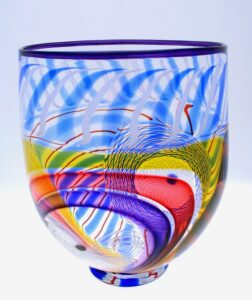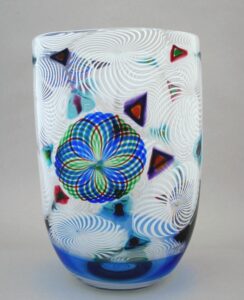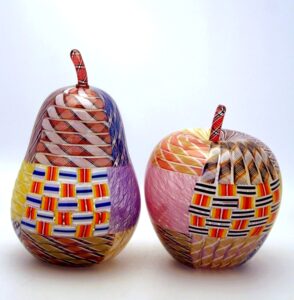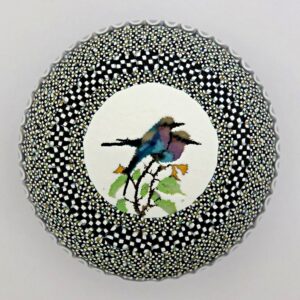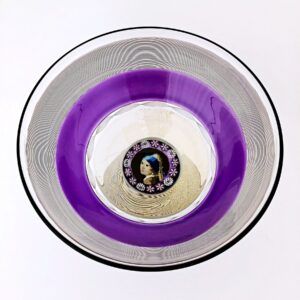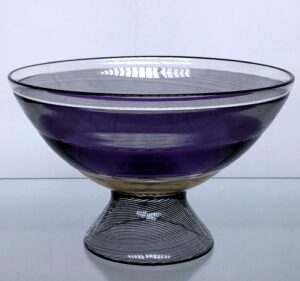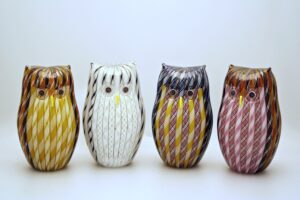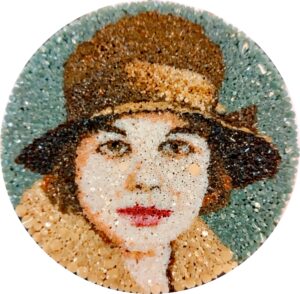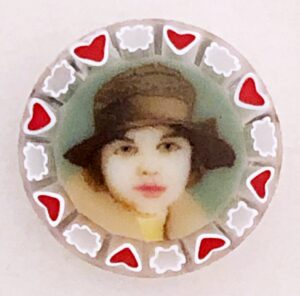So I left employment and all the BS behind. Fate was in my hands now, not those who designed, or sales, nor those who didn’t know much about the industry at all. It was in Sue’s and my hands to do all those things and get it right to survive. We had enough money behind us to survive the first few months but that’s it! There was no rich family to support us, we had thrown everything at a dream I’d had since 1981 and could have ended up on the streets if we failed. Apparently, this is called “The Full Monty”.
So business plans were drawn. Actually, we had been working on setting up a studio while I worked in Wales. I made some of the equipment, rib molds, jacks and the like, and even had some graphite molds turned out for wine glasses in Wales. Next, we found an old mill that the owners were going to turn into workshop units. Everything was falling into place!
Eventually, the units were built, the gas meter installed and the kiln and furnace equipment delivered. The furnace engineer said he had never known someone not involved in the industry pull everything together so quickly, Sue was a marvel on the phone!
So as the furnace was being “plumbed in”, and the flue installed, I started to panic, I needed to do a lot more at my end before the first pot of glass had refined. I welded steel to make two chairs, a pair of grabbers to put in and take out the pot rings and welded a back and sides to an old spade to use as a shovel. The cullet was washed and ready to be charged.
Now right at the beginning, there were two key policies we based all our work around, the first was Care for the environment, the second, keeping skills alive. This involved going back in time and making twisted stemmed glasses. We didn’t set out to make fakes or reproductions, although we did use some of the twist patterns from the 18th Century. It was more about being able to make these for everyday use. To avoid any confusion between the antique and our modern glasses I designed them to look right, but be completely wrong at the same time…I’ll explain, the shapes of the bowls were wrong, that shape was never made back then, So even in the first year when I put folded feet, or feet made using wooded footboards they still didn’t “look” right. Later I used a mechanical foot tool which gives the foot a square edge, and if that wasn’t enough, all these glasses were signed and dated by myself. But even though we did all this a few dealers of antique glass still told people we were making fakes…I guess they thought we would affect their business or perhaps it was just insecurity, who knows?
We made a few simple “studio” ranges to sell at trade fairs with the tableware ranges which consisted of 6 different cotton and colour twist stems plus an air-twist, which were used in our tot, port, white wine, red wine, ale, champagne and decanters, of which we had two shapes and one with a stem. I quickly discovered that customers only brought the style of stems we didn’t have in stock…our policy of making to order was born!
Our care for the environment policy was due to my love of nature and the fact that I work in a heavy pollutant industry. This policy didn’t just involve recycling factory waste “cullet” which we melted in our glass melting furnace. I also experimented with recycling our coloured waste. I found that if I melted all the colours together the melt turned blue as cobalt oxide is the strongest colourant by far. I started to segregate the colours, the amethyst red and amethyst blue gave a nice pale blue due to the tiny cobalt content, the manganese that forms purple burnt away. The topaz and ruby colours turned clear but with a dark tinge, the opals all turned transparent. The only colours I could make from our waste seemed to be green and blue. I have since segregated the greens into turquoise, lime green and green but haven’t melted the turquoise and lime greens yet. We also recycled other products, paper made from banana leaves that came on big rolls that made the bags for tea bags. We even emptied our tea bags into a bin to form compost for the garden. Which made a few people smile…Until we won a VIBES Scotland, Care for the Environment Award in 2002.
“Vetro” came from my love of experimenting with cane techniques. At the time we didn’t have buyers in mind, it was more of a case that I wanted to make them. I mixed techniques and colours to see how they came out. I experimented with reversing the axis using the incalmo technique to create my art. Technique is important the greatest glass maker of our time Lino Tagliapietra says “Without technique you have nothing”. I believe technique and control over the glass is key to being a good glassmaker, I’m so glad of my Wedgwood training and all the “trial and error” practices that taught me how to think outside of the box…to be different and stand out from the crowd which I feel is really important for your own identity, and in being an artist. Those who claim that they let the glass flow and do what it wants probably don’t have the same control those who have factory experience have.
So the designing flowed, one design led from another to another and so on throughout the following years. We’re not short of designs we have an imagination that doesn’t come from looking at other’s work, ours is original, and I have even come up with unique techniques I’d invented. Often we only make a handful of one design, and often they are all coloured differently, so even they are unique. I try to do this with as many of my designs as possible even with our production work.
In 2006 at a PCA Convention out in Millville NJ, USA, I saw how I could cut back on our CO2 footprint. In 2010 we put that into practice and reduced our carbon footprint, I can’t say by how much because we didn’t calculate it at the time…It didn’t become “fashionable” until recently. Anyway, we continued designing around our new working methods so we didn’t have to have the glass melting furnace burning 24/7 365, and gradually it was off for longer periods.
In 2017, with the glass melting furnace cold, I formed an experiment to see if I could make 6 footed tazzas full of cane work making everything just using clear and coloured rods. The experiment was a success, I then started to work out how some of our production work could be made using the same principles…Most were possible, it takes a lot longer for each piece, and much of our work I feel can be made using my methods, but for a few like the twisted stemmed glasses it simply isn’t viable.
In 2021 we started to record our gas usage and convert it into CO2 kgs. Using a calculation gained from the internet we calculated in our first years we created around 98 tons of CO2. From mid-July 2021-22 it was about 57 tons, and from mid-July 2022-23 we had reduced our carbon footprint to 4.1 tons. Granted we don’t work every day, with the furnace off we don’t have to.
We have won many accolades and awards, I am going over to the US in May for the first time since COVID-19, to give a presentation on my 50 Years in Glassmaking. Covering what I’ve achieved and learnt without any help of any kind. The talk is to coincide with the publication of an article I wrote on my experiences in the glass industry and taken from my book, My Life in Glassmaking. The Good, the Bad and the Ugly.
